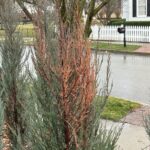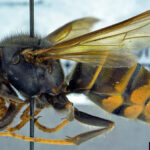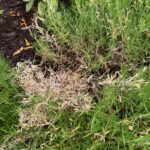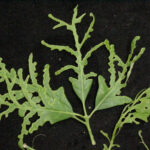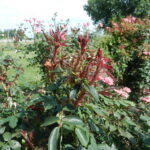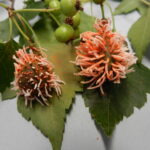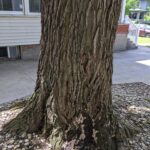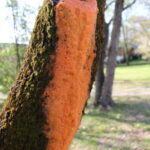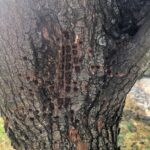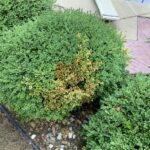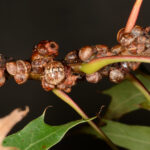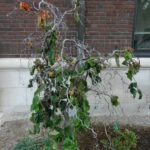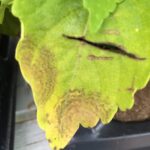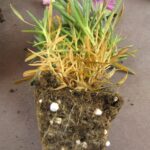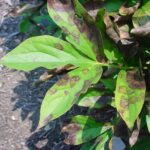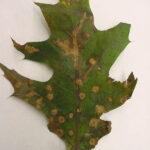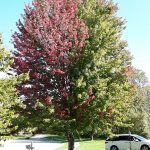Rocky Mountain juniper, Juniperus scopulorum, has gained some popularity in Midwest landscapes due to cold and drought tolerance, and to the availability of several upright columnar varieties with attractive blue color, including ‘Skyrocket’ and ‘Wichita Blue’. Like many other junipers, J. scopulorum may suffer dieback of small branches and twigs caused by the fungal pathogens[Read More…]
A new invasive insect of concern has been identified in the state of Georgia. In August of 2023, Georgia’s Department of Agriculture, along with the USDA, confirmed the presence of the yellow-legged hornet, Vespa velutina, outside of the city of Savannah. To date, this is the only confirmed identification of this insect in the United[Read More…]
Creeping phlox (Phlox subulata) has been a reliable mainstay in home landscapes for generations. This spring-blooming perennial is also known by a string of other common names, including flowering moss, moss phlox, moss pink, rock phlox, and thrift (not to be confused with sea thrift which is Armeria maritma). Creeping phlox is native to a[Read More…]
Each spring the PPDL receives several samples of oak trees showing curled, twisted, stunted and/or generally ratty looking leaves. When there are holes in the leaves or leaf edges are missing tissue, we add another symptom name to the mix: tatters. Distorted new growth and tatters are most common on white oaks and may occasionally[Read More…]
Rose rosette disease is a severe problem for rose growers and occurs widely throughout many rose growing regions of the US, especially from the mid-South into the Midwest. The problem was described on roses in the early 1940s but actual cause of the disease remained murky until the pathogen was identified as a virus in[Read More…]
Rust diseases produce some of the most dramatic symptoms and signs we see on woody plants in the landscape. These fungi live up to the name of ‘rust’ diseases because the spore structures they produce on the plant are generally bright orange, as shown by these examples: Cedar-apple rust (https://www.purduelandscapereport.org/article/orange-koosh-galls-on-eastern-red-cedar/), Hollyhock rust (https://www.purduelandscapereport.org/article/jolly-hollyhock-rust/) and Buckthorn[Read More…]
I enjoy gardening and take pride in the variety of flowers my wife and I manage to squeeze into a few beds each Summer. This year an interesting zinnia caught my eye and ended up in our back-yard garden. After fending off rabbits early in the season a new threat emerged in July: bacterial spots[Read More…]
Brittle cinders and burnt crusts usually bring to mind bad baking experiments, but in this case they are common names for a highly destructive wood rot fungus: Kretzschmaria deusta. The names derive from the charcoal-like fungal fruiting structure (the stroma), where spores are produced (Figure 1). Most wood decay fungi can be classified as[Read More…]
Arborvitae (Thuja spp.) fulfill several crucial roles in the landscape, especially windbreaks and screens (Fig. 1). Their relatively fast growth habit, wide variety of available forms, and inexpensive price point make them one of the most common conifers in the Midwest landscape. Due to the ubiquitous use of arborvitae, and their perceived problems, the Green[Read More…]
If you have ever seen gooey neon orange branches on trees and shrubs you may have been observing a phenomenon commonly known by the very scientific name of ‘orange goo’. Appearing in cool, wet weather during spring sap flow, the goo is caused by fungi, bacteria and yeast colonizing tree sap, especially where an injury[Read More…]
When we see round holes in the bark of a tree we often think the cause might be due to wood boring insects or bark beetles. However, that is not always the case. Small holes arranged in neat, uniform rows and columns on the trunks of trees or woody shrubs are usually caused by sapsuckers,[Read More…]
One of the most common diseases found on boxwoods is Volutella blight and dieback, caused by the fungi Pseudonectria foliicola and P. buxi. Both fungi are considered weak pathogens, always around but not causing much damage until plants are injured or stressed, rarely infecting otherwise healthy plants. Volutella blight alone usually doesn’t kill boxwoods, but[Read More…]
Northern red oak (Quercus rubra) is a Midwest native and is generally well adapted to growth across much of the region, but we get questions about dieback or ‘flagging’ on it fairly regularly. The two most common causes of twig dieback on this host are Kermes scale (Allokermes galliformis and A. kingii) and fungal canker/dieback[Read More…]
Contorted filbert is an ornamental cultivar of European Filbert, (Corylus avellana ‘Contorta’), grown for its twisted, gnarly stems. The plant is also sold under the name Harry Lauder’s Walking Stick. While it’s unique architecture can be impressive, it’s highly susceptible to a fungal canker that can cause extensive damage to the tree. Eastern filbert blight[Read More…]
First identified on coleus in the US in 2005, downy mildew has become an annual threat to production of this popular annual. The disease may be caused by the pathogens Peronospora lamii (also infects basil, as well as several species of Salvia and Lamium) or P. belbaharii (also infects basil). The symptoms may range from[Read More…]
Rhizomatous bearded iris (Iris x germanica) is a favorite early spring perennial; however, it is routinely troubled by a fungal leaf spot that tends to appear soon after flowering (Figure 1). These start as small wet-looking lesions that may quickly enlarge into larger spots with brownish edges, tan centers and yellow margins (Figure 2). When[Read More…]
Dianthus is a much-admired perennial, but occasionally it develops serious disease problems. The most dramatic of these is anthracnose, caused by the fungus Colletotrichum. The disease may spread rapidly on greenhouse benches or in landscape plantings of susceptible dianthus varieties. The old-fashioned ‘Sweet William’ varieties seem to tolerate this disease fairly well and may only[Read More…]
Leaf blotch, also called red spot and measles, is a common disease of peony caused by the fungus Graphiopsis chlorocephala (=Cladosporium paenoiae). The disease has multiple names because there are multiple symptoms. Lesion on leaves and stems can vary from tiny red spots (“measles”) to larger brown or purple blotches (Figures 1, 2 and 3).[Read More…]
Tubakia leaf spot, caused by the fungus Tubakia, is the disease we find more commonly on oak than any other. Throughout the world, there are 11 species of Tubakia known to infect oak, with Tubakia dryina (previously known as Actinopelte dryina) being the most commonly encountered species in our landscapes. Apple, ash, black gum, chestnut,[Read More…]
We often think of Phytophthora as mainly a root rot pathogen, but Phytophthora can also cause a bleeding trunk canker under the right conditions. The most commonly attacked trees we see in the diagnostic lab are American and European beech (Fagus spp.), and maples (Acer spp.); but this disease is also reported to occur on[Read More…]

